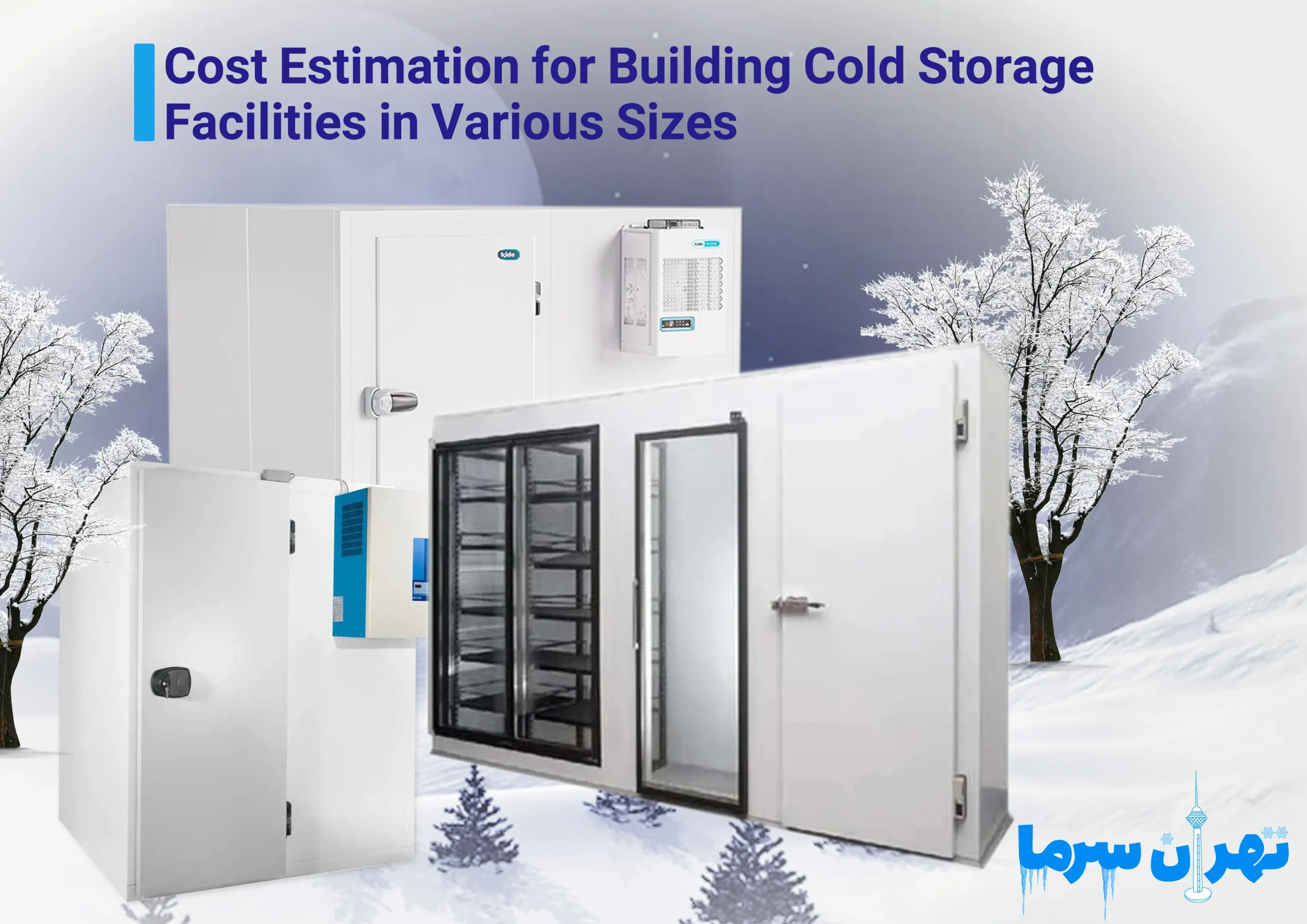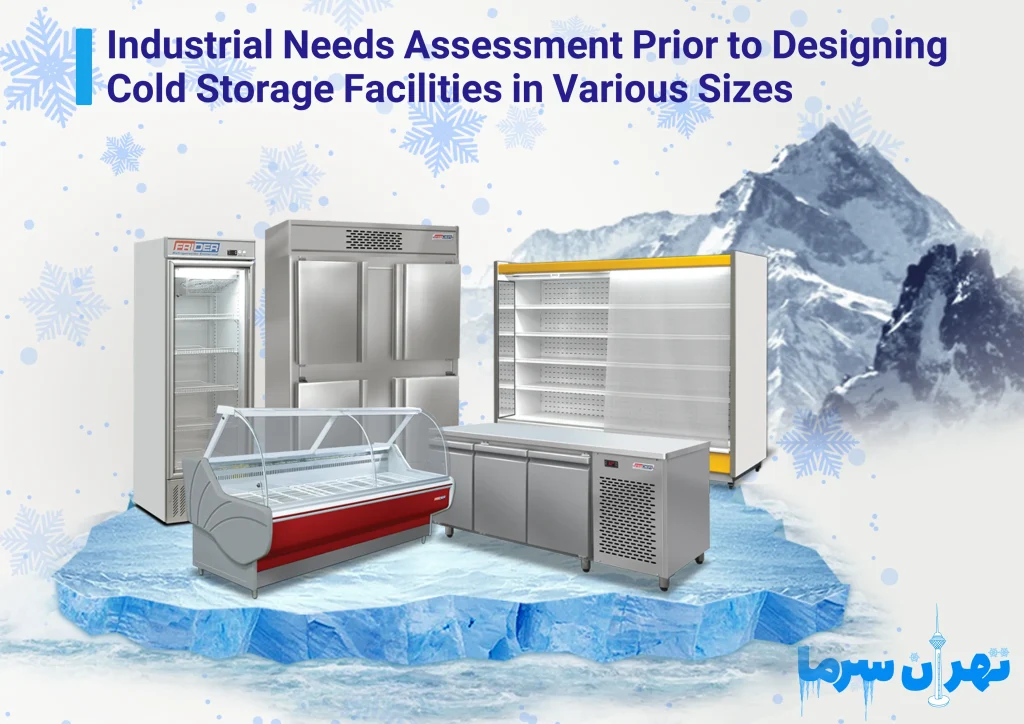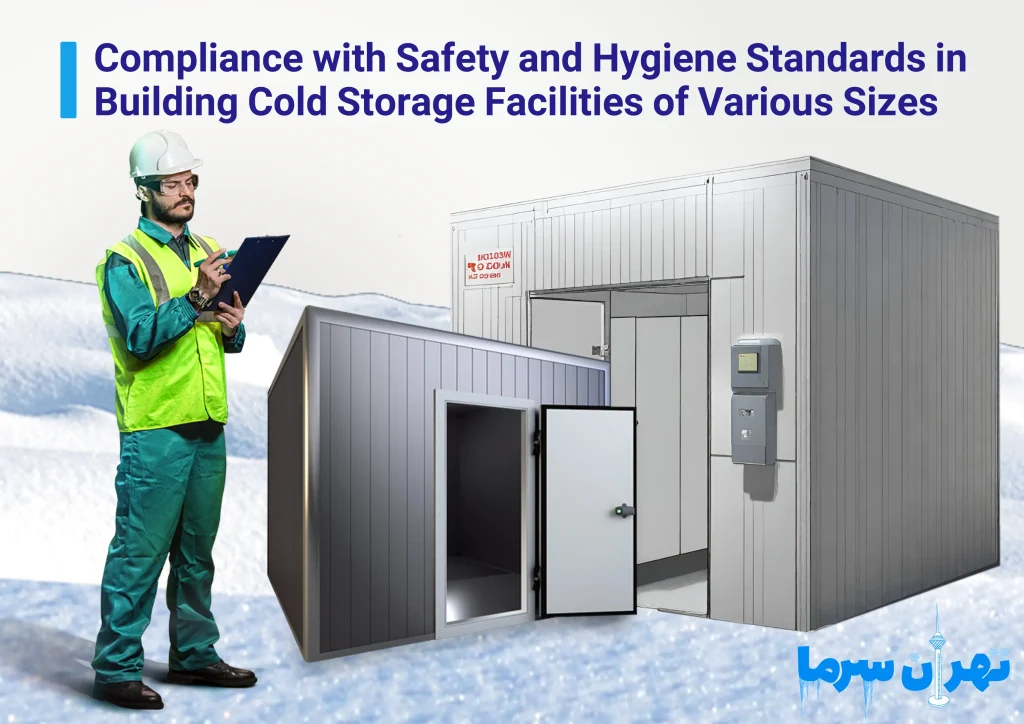Cost Estimation for Building Cold Storage Facilities in Various Sizes

Building cold storage facilities in various sizes and designing them accordingly is carried out based on the type of application, environmental conditions, and customer needs to achieve optimal performance and efficiency. The cost of constructing cold storage in different sizes varies depending on factors such as the desired capacity, type of equipment, insulation, and installation site, and should be estimated after a thorough review of the project specifications.
Estimating the cost of constructing cold storage in various sizes is a multidimensional and complex process that requires detailed examination of a set of technical, economic, and operational parameters. Contrary to the common misconception that cost is limited merely to the physical dimensions of the project, the reality is that the size of the cold storage is only one of the determining factors. Many other elements—including the type of application, required standards, and the technologies used—directly impact the final budget. For example, two cold storage units with the same volume may have significantly different construction costs depending on the cooling system type, insulation material, and location of implementation.
Selecting the Appropriate Capacity in Building Cold Storage Facilities in Various Sizes
At the design stage, choosing capacity and dimensions must be accompanied by a precise needs analysis. This analysis includes evaluating the type of products to be stored, storage duration, inflow and outflow rates of goods, and even the climatic conditions of the construction site.
For instance, a cold storage designed for storing sensitive pharmaceutical products in a hot and humid region requires more advanced equipment, more precise control systems, and insulation with very low thermal conductivity, which naturally increases construction costs. Conversely, a small cold storage for fruit storage in cold regions demands less investment in equipment and energy.
Selecting the Appropriate Cooling System in Designing Cold Storage Facilities in Various Sizes
The choice of cooling system also plays a key role in estimating the construction cost of cold storage in different sizes. Various technologies exist, including compression, absorption, and hybrid systems, each with its own advantages, disadvantages, and specific costs.
Furthermore, using modern, energy-efficient equipment, although possibly more expensive in the initial investment phase, can significantly reduce operational costs in the long term.
These decisions must be made within the framework of a cost-benefit analysis and considering the payback period to ensure economic sustainability of the project.
Operational factors also influence this process. Costs related to site preparation, foundation construction, three-phase power supply, and compliance with safety and hygiene requirements can consume a significant portion of the budget. Additionally, transportation and installation costs of equipment—especially in remote or difficult-to-access areas—must be carefully included in the final estimate.
Sometimes, incidental costs arising from delays in parts supply or mid-project specification changes lead to unexpected cost increases, making financial risk management a key requirement of the project.
The Importance of Accurate Cost Estimation for Building Cold Storage Facilities in Various Sizes
Estimating the cost of constructing cold storage in different sizes is more than a simple calculation based on square or cubic meters; it is a comprehensive analytical process requiring the integration of technical knowledge, practical experience, and a deep understanding of market conditions and modern technologies.
Success in this stage not only guarantees project execution within budget but is also a crucial factor in achieving optimal performance, longer equipment lifespan, and reduced operational costs in the following years. Therefore, leveraging specialized consulting and design teams, along with transparency in all decision-making stages, is essential to achieve an accurate and realistic estimate.
Industrial Needs Assessment Prior to Designing Cold Storage Facilities in Various Sizes
Conducting an industrial needs assessment prior to designing cold storage in various sizes is one of the most important initial steps in establishing such infrastructure and plays a decisive role in the technical, economic, and operational success of the project. This stage is not limited merely to selecting capacity or overall dimensions but includes a comprehensive analysis of current conditions and forecasting future needs of the target business or industry. Neglecting this assessment can lead to improper design, over- or under-investment, and ultimately reduced return on investment.
The industrial needs assessment process typically begins with gathering detailed data on product types, production or supply volume, storage duration, and specific temperature and humidity conditions.
For example, designing a cold storage for storing frozen protein products has completely different requirements than one intended for fresh fruits and vegetables. Furthermore, inflow and outflow rates, inventory fluctuations, and even seasonal demand patterns must be carefully reviewed to ensure that the designed capacity can meet all operational scenarios.
Environmental and geographical conditions of the construction site also constitute an important part of the needs assessment. Factors such as average annual temperature, relative humidity, quality of energy and transportation infrastructure, and even local regulations affect the choice of cooling technology, insulation, and control systems. In hot and humid regions, higher-capacity cooling systems and advanced insulation may be necessary, directly influencing construction and operating costs.
Industrial needs assessment must also consider project scalability. Many industries, especially in food and pharmaceuticals, experience capacity increases or product type changes over time. Designing cold storage in various sizes without anticipating these changes may result in future redesigns or reinvestments. Therefore, flexibility in design and forecasting the possibility of upgrading equipment or expanding space is an integral part of this phase.
The industrial needs assessment prior to designing cold storage in various sizes not only helps select optimal dimensions and appropriate technology but also prevents hidden costs, operational inefficiencies, and reduced storage quality. This process lays the foundation for a successful and sustainable project and should be conducted through close collaboration among the client, technical consultants, and execution teams, accompanied by precise data analysis and deep market insight.
Engineering Design and Selection of Refrigeration Systems in Building Cold Storage Facilities of Various Sizes
Engineering design and selection of refrigeration systems in constructing cold storage facilities of different sizes is one of the most critical and decisive stages in the cold storage establishment process. This phase directly impacts performance, energy consumption, operational costs, and even the equipment lifespan. Contrary to common belief, selecting a cooling system is not limited merely to determining the cooling capacity but requires a comprehensive engineering approach considering multiple factors such as the cold storage’s application type, local climate conditions, hygiene requirements, and international standards.
The design process begins with accurately defining the required temperature and humidity conditions. For example, a cold storage designed to preserve frozen meat at -18°C needs different equipment compared to a facility intended for storing fresh vegetables at positive temperatures. The choice of refrigeration system type—such as air-cooled, water-cooled, or evaporative compression systems—must be based on the required capacity, installation space, and environmental constraints. At this stage, precise heat load calculations are performed to ensure equipment is neither undersized nor oversized unnecessarily.
Selecting main refrigeration system components like compressors, evaporators, and condensers should consider energy efficiency, reliability, and ease of maintenance. Utilizing scroll or screw compressors equipped with inverter technology can significantly reduce energy consumption and extend system life. Additionally, designing piping layouts and choosing appropriate refrigerants are critically important. Adhering to environmental standards by selecting low-global-warming-potential (GWP) refrigerants improves project sustainability while ensuring regulatory compliance.
Control and automation are also integral to engineering design in cold storage construction of various sizes. Implementing digital control systems and intelligent monitoring of temperature and humidity not only enhances operational accuracy but also enables energy management and lowers operational costs. These technologies aid in the early detection of potential faults, preventing sudden breakdowns and costly repairs.
Overall, engineering design and selection of refrigeration systems in building cold storage facilities of different sizes is a multi-layered, specialized process requiring the integration of technical knowledge, practical experience, and awareness of the latest global technologies and standards. Proper decision-making at this stage can distinguish between an inefficient cold storage and a sustainable, economical, and efficient infrastructure. Therefore, collaborating with specialized engineering teams and consultants is an indispensable necessity to achieve the best results.
Energy Management and Performance Optimization of Equipment in Building Cold Storage Facilities of Various Sizes
Energy management and optimizing the performance of equipment in cold storage construction of different sizes are among the most crucial factors in reducing operational costs and extending equipment lifespan. Considering that refrigeration systems account for the majority of energy consumption in cold storage, intelligent design and selection of high-efficiency equipment play a key role in improving productivity. Using inverter compressors, low-power fans on evaporators, and optimized condensers are among measures that can significantly reduce electricity usage.
Moreover, implementing smart control systems and continuous monitoring of parameters such as temperature, humidity, and operating pressure enable precise adjustment and help prevent energy waste. Besides equipment, proper insulation of walls, ceilings, and floors is vital in preventing energy loss and maintaining stable internal conditions. Routine servicing and preventive maintenance not only sustain optimal equipment performance but also prevent increased energy consumption caused by reduced efficiency.
Adopting a comprehensive approach that includes optimized design, use of modern technologies, and compliance with energy efficiency standards can transform cold storage construction of various sizes into an economically and environmentally sustainable project.
Compliance with Safety and Hygiene Standards in Building Cold Storage Facilities of Various Sizes
Compliance with safety and hygiene standards in constructing cold storage facilities of different sizes is a fundamental principle for ensuring the quality and health of stored products and plays a vital role in protecting the safety of staff and users. This goes beyond mere legal compliance and involves implementing international standards such as HACCP, ISO 22000, and industry-specific regulations for food and pharmaceuticals that control storage conditions, prevent contamination, and maintain the cold chain.
Cold storage design must facilitate easy and effective cleaning of all surfaces and ensure that ventilation, lighting, and wastewater disposal systems conform to hygiene and environmental principles. Regarding safety, installing fire suppression equipment, alarm systems, and conducting staff training programs are indispensable requirements. Additionally, attention to electrical safety, structural resistance to emergencies, and maintaining safety clearances within the interior design are crucial components of these requirements.
Strict adherence to these standards not only prevents financial losses and legal penalties but also enhances customer trust and preserves brand value in a competitive market. Therefore, integrating these requirements throughout all stages of design, construction, and operation of cold storage facilities in various sizes is a comprehensive and strategic approach essential for project success and sustainability.
Building Cold Storage Facilities with the Support of Tehran Sarma Engineering Company
Building cold storage facilities with the support of Tehran Sarma Engineering Company is a professional and reliable experience that, relying on specialized knowledge, modern technologies, and an experienced team, comprehensively manages all stages of design, equipment supply, and project execution according to standards.
With a deep understanding of market needs and leveraging innovative engineering solutions, this company can construct cold storages of various sizes with high efficiency and optimized energy consumption, tailored to the specific characteristics of each business.
Collaboration with Tehran Sarma guarantees timely project delivery, high-quality results, and full compliance with safety and hygiene standards, assuring clients that their investment carries minimal risk and maximum return.
For more information about cold storage construction pricing, you can visit Tehran Sarma’s website or contact the numbers 09121906418 and 02177972256.
Ultimately, building and designing cold storage facilities in various sizes plays a significant role in meeting the diverse needs of industries and businesses. By selecting the right capacity, equipment, and construction method, one can enhance product longevity, energy efficiency, and system performance. Construction costs for cold storage in different sizes are determined based on technical specifications and execution conditions.
Source:
https://www.coldstorageus.com/




 سردخانه
سردخانه برق
برق کمپرسور
کمپرسور کمپرسور بیتزر
کمپرسور بیتزر کمپرسور کوپلند
کمپرسور کوپلند کمپرسور بوک
کمپرسور بوک کمپرسور دانفوس
کمپرسور دانفوس کمپرسور منیروپ دانفوس
کمپرسور منیروپ دانفوس کمپرسور امبراکو
کمپرسور امبراکو کمپرسور پاناسونیک
کمپرسور پاناسونیک کمپرسور سابکول
کمپرسور سابکول کمپرسور کوپلند
کمپرسور کوپلند کمپرسور اسکرال کوپلند
کمپرسور اسکرال کوپلند کمپرسورفراسکلد
کمپرسورفراسکلد کمپرسور رفکامپ
کمپرسور رفکامپ کمپرسور اسکرال دانفوس
کمپرسور اسکرال دانفوس گاز مبرد
گاز مبرد گاز R22
گاز R22 گاز R134
گاز R134 گاز R404
گاز R404 گاز R407
گاز R407 گاز R410
گاز R410 گاز R508
گاز R508 کندانسور هوایی
کندانسور هوایی اواپراتور
اواپراتور اواپراتور آرشه
اواپراتور آرشه اواپراتور صابکول
اواپراتور صابکول اواپراتور آسه
اواپراتور آسه اواپراتور نیک
اواپراتور نیک اواپراتور آرتک
اواپراتور آرتک اواپراتور نوین
اواپراتور نوین اواپراتور تبادل کار
اواپراتور تبادل کار درب
درب ساندویچ پنل
ساندویچ پنل فن سردخانه
فن سردخانه روغن کمپرسور سانیسو
روغن کمپرسور سانیسو متعلقات سردخانه
متعلقات سردخانه